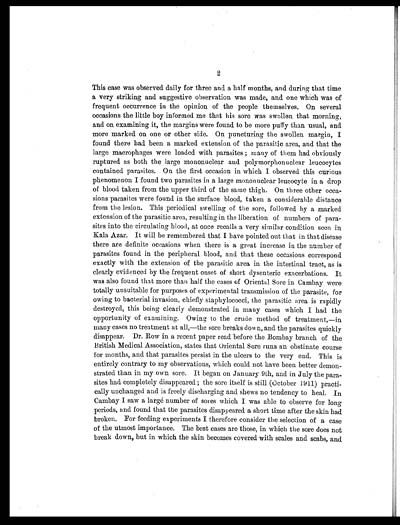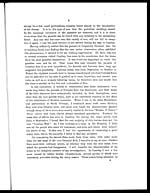Medicine - Institutions > Army health reports and medical documents > Scientific memoirs by officers of the Medical and Sanitary Departments of the Government of India > Number 50 - Preliminary report on an investigation into the etiology of Oriental sore in Cambay > Preliminary report on an investigation into the etiology of Oriental sore in Cambay
(12) Page 2
Download files
Individual page:
Thumbnail gallery: Grid view | List view

2
This case was observed daily for three and a half months, and during that time
a very striking and suggestive observation was made, and one which was of
frequent occurrence in the opinion of the people themselves. On several
occasions the little boy informed me that his sore was swollen that morning,
and on examining it, the margins were found to be more puffy than usual, and
more marked on one or other side. On puncturing the swollen margin, I
found there had been a marked extension of the parasitic area, and that the
large macrophages were loaded with parasites; many of them had obviously
ruptured as both the large mononuclear and polymorphonuclear leucocytes
contained parasites. On the first occasion in which I observed this curious
phenomenon I found two parasites in a large mononuclear leucocyte in a drop
of blood taken from the upper third of the same thigh. On three other occa-
sions parasites were found in the surface blood, taken a considerable distance
from the lesion. This periodical swelling of the sore, followed by a marked
extension of the parasitic area, resulting in the liberation of numbers of para-
sites into the circulating blood, at once recalls a very similar condition seen in
Kala Azar. It will be remembered that I have pointed out that in that disease
there are definite occasions when there is a great increase in the number of
parasites found in the peripheral blood, and that these occasions correspond
exactly with the extension of the parasitic area in the intestinal tract, as is
clearly evidenced by the frequent onset of short dysenteric exacerbations. It
was also found that more than half the cases of Oriental Sore in Cambay were
totally unsuitable for purposes of experimental transmission of the parasite, for
owing to bacterial invasion, chiefly staphylococci, the parasitic area is rapidly
destroyed, this being clearly demonstrated in many cases which I had the
opportunity of examining. Owing to the crude method of treatment,—in
many cases no treatment at all,—the sore breaks down, and the parasites quickly
disappear. Dr. Row in a recent paper read before the Bombay branch of the
British Medical Association, states that oriental Sore runs an obstinate course
for months, and that parasites persist in the ulcers to the very end. This is
entirely contrary to my observations, which could not have been better demon-
strated than in my own sore. It began on January 9th, and in July the para-
sites had completely disappeared; the sore itself is still (October 1911) practi-
cally unchanged and is freely discharging and shews no tendency to heal. In.
Cambay I saw a large number of sores which I was able to observe for long
periods, and found that the parasites disappeared a short time after the skin had
broken. For feeding experiments I therefore consider the selection of a case
of the utmost importance. The best cases are those, in which the sore does not
break down, but in which the skin becomes covered with scales and scabs, and.
Set display mode to: Large image | Zoom image | Transcription
Images and transcriptions on this page, including medium image downloads, may be used under the Creative Commons Attribution 4.0 International Licence unless otherwise stated. ![]()
| Permanent URL | https://digital.nls.uk/75061455 |
|---|
| Shelfmark | IP/QB.10 |
|---|---|
| Additional NLS resources: | |



![[Page 1]](https://deriv.nls.uk/dcn4/7506/75061454.4.jpg)
